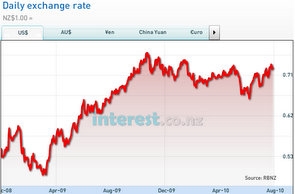
By Mike Jones*
The NZD/USD has spent most of the past 24 hours consolidating within a 0.7300-0.7360 range.
Once again, the NZD/USD found support from a broadly weaker US dollar overnight. Last night’s US data was fairly uninspiring, and only added to concerns US economic growth is slowing.
Indeed, June readings of US pending home sales, factory orders, and personal spending all fell short of market expectations, sending already rock-bottom US bond yields lower still.
At 0.53%, 2-year US Government bond yields are close to the lowest on record.
Against the tumbling USD, the JPY, EUR and GBP all jumped to multi-month highs, with the NZD dragged higher in their slipstream.
After a brief dip following last week’s dovish RBNZ statement, NZ-US 3-year swap spreads have re-widened to almost 330bps, further boosting the attractiveness of the NZD for momentum and short-term speculative players.
Still, a slide in NZD/JPY from 63.50 to below 63.00 tended to limit NZD/USD gains to the 0.7350 region.
Japanese Finance Minister Noda last night said the JPY should “basically be set by the market”, effectively providing the green light for further near-term JPY strength.
The NZD largely shrugged off a weaker result from last night’s Fonterra online milk price auction. Following last month’s 13.7%m/m decline, milk prices fell a further 8.3% in August – a bit more than we had expected.
Along with Monday’s 0.8% decline in the ANZ commodity price index, this provides further support to our supposition NZ’s commodity export prices have peaked.
Looking ahead, a test of 2010’s 0.7440 high in NZD/USD remains on the cards as long as the trend for a weaker USD continues and risk appetite holds up.
However, tomorrow’s HLFS labour market report presents a key near-term hurdle for additional NZD gains.
We expect the jobless rate ticked up a bit from 6.0% to 6.3% in Q2.
Majors
Familiar themes prevailed in currency markets overnight. Broad-based US dollar weakness meant most of the major currencies strengthened ‘by default’. The recent slide in the USD has coincided with signs of flagging momentum in the US economy, and concerns the Federal Reserve will maintain its extremely accommodative monetary policy stance for some time to come.
Last night’s US data did nothing to allay these concerns. Not only did June data show US pending home sales sliding a further 2.6%m/m (+4.0%m/m expected), but personal spending flat-lined (+0.1% expected) and June factory orders fell by more than expected (-1.2% vs. -0.5% expected).
US bond yields dropped accordingly, weighing on the USD. 2-year Treasury yields dipped 3bps to 0.52% and 10-year yields fell 5bps to 2.91%.
A Wall Street Journal article suggesting the Fed may signal a move towards additional quantitative easing measures (printing money) at its August 10 meeting also provided headwinds for the USD overnight. USD/JPY plunged from 86.60 to 8-month lows around 85.80, amid further contraction in US-JP 2-year bond spreads (to 38bps, a 19-month low).
Markets are abuzz with chatter about possible Bank of Japan intervention to counter JPY strength. However, comments from Japanese finance minister Noda that “foreign exchange rates are something that should basically be set by the market” were interpreted as a green light to keep buying JPY.
The USD also skidded to fresh lows against the EUR and GBP. EUR/USD drifted up from 1.3160 to above 1.3240, while GBP/USD was propelled to 6-month highs of nearly 1.5960, before softer-than-expected July construction PMI figures (54.1 vs. 58.0 expected) capped the topside. Stock markets were fairly mixed overnight, but for the most part recorded small falls after Tuesday night’s outsized gains.
European bourses were mostly flattish, while the S&P500 slipped 0.5% amid disappointing Q2 profit results from Dow Chemical Co. and Procter & Gamble. Looking ahead, US data looks set to remain in the spotlight. Any further evidence of a slowing in underlying activity would see the USD continue to slide.
Against this backdrop, Friday’s non-farm payrolls employment report for July will take on added importance.
Current expectations are for a 60,000 employment drop In the short-term, we suspect the current backdrop of reduced yield support will keep the USD heavy. Expect any rallies towards 81.50 on the USD index to attract resistance.
* Mike Jones is part of the BNZ research team.
All its research is available here.
No chart with that title exists.
We welcome your comments below. If you are not already registered, please register to comment.
Remember we welcome robust, respectful and insightful debate. We don't welcome abusive or defamatory comments and will de-register those repeatedly making such comments. Our current comment policy is here.